Transthyretin Upregulates Long Non-Coding RNA MEG3 by Affecting PABPC1 in Diabetic Retinopathy
Abstract
1. Introduction
2. Results
2.1. The Protective Effects of TTR on Retinas of DR Mice
2.2. TTR Interacted with Poly(A) Binding Protein Cytoplasmic 1 (PABPC1) to Stabilize lncRNA-MEG3
2.3. TTR Effects Proliferation, Migration, and Vascularization by Regulating lncRNA-MEG3
2.4. LncRNA-MEG3 Functions as the ceRNA of miR-223-3p in DR
2.5. Overexpression of miR-223-3p Rescues the Inhibitory Effect of TTR on Neovascularization
2.6. TTR/LncRNA-MEG3/Axis Regulated Neovascularization in DR
3. Discussion
4. Materials and Methods
4.1. Ethics Statement
4.2. Proliferation Assay
4.3. Vascular Tube Formation Assay
4.4. Cell Migration and Healing Assay
4.5. qRT-PCR
4.6. Co-Immunoprecipitation (Co-IP) Assay and Western Blot Analysis
4.7. Diabetes and DR Mouse Models Induced with Streptozotocin (STZ)
4.8. Retinal Imaging
4.9. Evans Blue (EB) Leak Assay
4.10. Trypsin Digestion of Retina
4.11. Luciferase Reporter Assays
4.12. Statistical Analysis
5. Conclusions
Author Contributions
Funding
Conflicts of Interest
Abbreviations
| MDPI | Multidisciplinary Digital Publishing Institute |
| DOAJ | Directory of open access journals |
| TLA | Three letter acronyms |
| LD | Linear dichroism |
| DR | Diabetic retinopathy |
| TTR | Transthyretin |
| LncRNA | Long non-coding RNA |
| MEG3 | Maternally expressed gene 3 |
| LncRNA-MEG3 | Long non-coding RNA of maternally expressed gene 3 |
| shRNA | Short hairpin RNA |
| miR-223-3p | Micro RNA-223-3p |
| PABPC1 | Polyadenylate-binding protein cytoplasmic 1 |
| hRECs | Human retinal microvascular endothelial cells |
| Co-IP | Co-immunoprecipitation |
| hRPECs | Human retinal pigment epithelial cells |
| GRP78 | 78-kDa glucose-regulated protein |
| ceRNA | Competing endogenous RNA |
| OCT | Optical coherence tomography |
| HEK293 | Human embryonic kidney 293 |
| silncRNA-MEG3 | Small interfering lncRNA-MEG3 |
| OE lncRNA-MEG3 | Overexpression lncRNA-MEG3 |
References
- Solomon, S.D.; Chew, E.; Duh, E.J.; Sobrin, L.; Sun, J.K.; VanderBeek, B.L.; Wykoff, C.C.; Gardner, T.W. Diabetic retinopathy: A position statement by the American Diabetes Association. Diabetes Care 2017, 40, 412–418. [Google Scholar] [CrossRef] [PubMed]
- Wang, Y.X.; Xu, L.; Sun, X.Y.; Zou, Y.; Zhang, H.T.; Jonas, J.B. Five year incidence of visual field loss in adult Chinese. The Beijing Eye Study. PLoS ONE 2012, 7, e37232. [Google Scholar] [CrossRef] [PubMed]
- Klein, B.E.K.; Horak, K.L.; Maynard, J.D.; Lee, K.E.; Klein, R. Association of Skin Intrinsic Fluorescence with Retinal Microvascular Complications of Long Term Type 1 Diabetes in the Wisconsin Epidemiologic Study of Diabetic Retinopathy. Ophthal. Epidemiol. 2017, 24, 211–216. [Google Scholar] [CrossRef] [PubMed]
- Clément, M.; Lebreton, O.; Chaillous, L.; Weber, M. Evaluation of diabetic retinopathy screening using fundus photography: Evaluation and epidemiologic factors at Nantes university medical center. J. Fr. Ophtalmol. 2019, 42, 281–287. [Google Scholar] [CrossRef]
- She, C.; Shang, F.; Zhou, K.; Liu, N. Serum Carotenoids and Risks of Diabetes and Diabetic Retinopathy in a Chinese Population Sample. Curr. Mol. Med. 2017, 17, 287–297. [Google Scholar] [CrossRef]
- Sharma, A.; Valle, M.L.; Beveridge, C.; Liu, Y.; Sharma, S. Unraveling the role of genetics in the pathogenesis of diabetic retinopathy. Eye 2019, 33, 534–541. [Google Scholar] [CrossRef]
- Vieira, M.; Saraiva, M.J. Transthyretin: A multifaceted protein. Biomol. Concepts 2014, 5, 45–54. [Google Scholar] [CrossRef]
- Hamilton, J.A.; Benson, M.D. Transthyretin: A review from a structural perspective. Cell. Mol. Life Sci. 2001, 58, 1491–1521. [Google Scholar] [CrossRef]
- Woeber, K.A.; Ingbar, S.H. The contribution of thyroxine-binding prealbumin to the binding of thyroxine in human serum, as assessed by immunoadsorption. J. Clin. Investig. 1968, 47, 1710–1721. [Google Scholar] [CrossRef]
- Pullakhandam, R.; Palika, R.; Ghosh, S.; Reddy, G.B. Contrasting effects of type 2 and type 1 diabetes on plasma RBP4 levels: The significance of transthyretin. IUBMB Life 2012, 64, 75–82. [Google Scholar] [CrossRef]
- Lim, L.S.; Lamoureux, E.; Saw, S.M.; Tay, W.T.; Mitchell, P.; Wong, T.Y. Are myopic eyes less likely to have diabetic retinopathy? Ophthalmology 2010, 117, 524–530. [Google Scholar] [CrossRef] [PubMed]
- Moss, S.E.; Klein, R.; Klein, B.E. Ocular factors in the incidence and progression of diabetic retinopathy. Ophthalmology 1994, 101, 77–83. [Google Scholar] [CrossRef]
- Shao, J.; Xin, Y.; Li, R.X.; Fan, Y. Vitreous and serum levels of transthyretin (TTR) in high myopia patients arecorrelated with ocular pathologies. Clin. Biochem. 2011, 44, 681–685. [Google Scholar] [CrossRef] [PubMed]
- Shao, J.; Yao, Y. Negative effects of transthyretin in high myopic vitreous on diabetic retinopathy. Int. J. Ophthalmol. 2017, 10, 1864–1869. [Google Scholar]
- Shao, J.; Yao, Y. Repression of retinal microvascular endothelial cells by transthyretin under diabetic retinopathy condition. Int. J. Ophthalmol. 2016, 7, 809–815. [Google Scholar]
- Shao, J.; Yao, Y. Transthyretin represses neovascularization in diabetic retinopathy. Mol. Vis. 2016, 22, 1188–1197. [Google Scholar]
- Shao, J.; Yin, Y.; Yin, X.; Ji, L.; Xin, Y.; Zou, J.; Yao, Y. Transthyretin Exerts Pro-Apoptotic Effects in Human Retinal Microvascular Endothelial Cells Through a GRP78-Dependent Pathway in Diabetic Retinopathy. Cell. Physiol. Biochem. 2017, 43, 788–800. [Google Scholar] [CrossRef]
- LaPierre, M.P.; Stoffel, M. MicroRNAs as stress regulators in pancreatic beta cells and diabetes. Mol. Metab. 2017, 6, 1010–1023. [Google Scholar] [CrossRef]
- Boon, R.A.; Jaé, N.; Holdt, L.; Dimmeler, S. Long Noncoding RNAs: From Clinical Genetics to Therapeutic Targets? J. Am. Coll. Cardiol. 2016, 67, 1214–1226. [Google Scholar] [CrossRef]
- Li, F.; Wen, X.; Zhang, H.; Fan, X. Novel Insights into the Role of Long Noncoding RNA in Ocular Diseases. Int. J. Mol. Sci. 2016, 17, 478. [Google Scholar] [CrossRef]
- Cissé, Y.; Bai, L.; Meng, T. LncRNAs in genetic basis of glaucoma. BMJ Open Ophthalmol. 2018, 3, e000131. [Google Scholar] [CrossRef] [PubMed]
- Johnson, W.M.; Finnegan, L.K.; Hauser, M.A.; Stamer, W.D. lncRNAs, DNA Methylation, and the Pathobiology of Exfoliation Glaucoma. J. Glaucoma. 2018, 27, 202–209. [Google Scholar] [CrossRef] [PubMed]
- Wu, X.Z.; Cui, H.P.; Lv, H.J.; Feng, L. Knockdown of lncRNA PVT1 inhibits retinoblastoma progression by sponging miR-488-3p. Biomed. Pharmacother. 2019, 112, 108627. [Google Scholar] [CrossRef] [PubMed]
- Cheng, Y.; Chang, Q.; Zheng, B.; Xu, J.; Li, H.; Wang, R. LncRNA XIST promotes the epithelial to mesenchymal transition of retinoblastoma via sponging miR-101. Eur. J. Pharmacol. 2019, 843, 210–216. [Google Scholar] [CrossRef] [PubMed]
- Gong, Q.; Su, G. Roles of miRNAs and long noncoding RNAs in the progression of diabetic retinopathy. Biosci. Rep. 2017, 37, BSR20171157. [Google Scholar] [CrossRef] [PubMed]
- Yan, B.; Tao, Z.F.; Li, X.M.; Zhang, H.; Yao, J.; Jiang, Q. Aberrant expression of long noncoding RNAs in early diabetic retinopathy. Investig. Ophth. Vis. Sci. 2014, 55, 941–951. [Google Scholar] [CrossRef]
- Toraih, E.A.; Abdelghany, A.A.; Abd El Fadeal, N.M.; Al Ageeli, E.; Fawzy, M.S. Deciphering the role of circulating lncRNAs: RNCR2, NEAT2, CDKN2B-AS1, and PVT1 and the possible prediction of anti-VEGF treatment outcomes in diabetic retinopathy patients. Graefes Arch. Clin. Exp. Ophthalmol. 2019, 257, 1897–1913. [Google Scholar] [CrossRef]
- Liu, P.; Jia, S.B.; Shi, J.M.; Li, W.J.; Tang, L.S.; Zhu, X.H.; Tong, P. LncRNA-MALAT1 promotes neovascularization in diabetic retinopathy through regulating miR-125b/VE-cadherin axis. Biosci. Rep. 2019, 39, BSR20181469. [Google Scholar] [CrossRef]
- Thomas, A.A.; Biswas, S.; Feng, B.; Chen, S.; Gonder, J.; Chakrabarti, S. LncRNA H19 prevents endothelial-mesenchymal transition in diabetic retinopathy. Diabetologia 2019, 62, 517–530. [Google Scholar] [CrossRef]
- Zhang, Y.; Liu, X.; Bai, X.; Lin, Y.; Li, Z.; Fu, J.; Li, M.; Zhao, T.; Yang, H.; Xu, R.; et al. Melatonin prevents endothelial cell pyroptosis via regulation of long noncoding RNA MEG3/miR-223/NLRP3 axis. J. Pineal Res. 2018, 64, e12449. [Google Scholar] [CrossRef]
- Qiu, G.Z.; Tian, W.; Fu, H.T.; Li, C.P.; Liu, B. Long noncoding RNA-MEG3 is involved in diabetes mellitus-related microvascular dysfunction. Biochem. Bioph. Res. Commun. 2016, 471, 135–141. [Google Scholar] [CrossRef] [PubMed]
- Shao, J.; Fan, G.M.; Yin, X.W.; Yu, G.; Wang, X.L.; Xin, Y.; Yao, Y. A novel transthyretin/STAT4/miR-223-3p/FBXW7 signaling pathway affects neovascularization in diabetic retinopathy. Mol. Cell. Endocrinol. 2019, 498, 110541. [Google Scholar] [CrossRef] [PubMed]
- Zhang, H.; Sheng, C.; Yin, Y.; Wen, S.; Yang, G.; Cheng, Z.; Zhu, Q. PABPC1 interacts with AGO2 and is responsible for the microRNA mediated gene silencing in high grade hepatocellular carcinoma. Cancer Lett. 2015, 367, 49–57. [Google Scholar] [CrossRef] [PubMed]
- Stupfler, B.; Birck, C.; Séraphin, B.; Mauxion, F. BTG2 bridges PABPC1 RNA-binding domains and CAF1 deadenylase to control cell proliferation. Nat. Commun. 2016, 7, 10811. [Google Scholar] [CrossRef]
- Peng, Y.; Yuan, J.; Zhang, Z.; Chang, X. Cytoplasmic poly(A)-binding protein 1 (PABPC1) interacts with the RNA-binding protein hnRNPLL and thereby regulates immunoglobulin secretion in plasma cells. J. Biol. Chem. 2017, 292, 12285–12295. [Google Scholar] [CrossRef] [PubMed]
- Xiao, W.; Chen, X.; He, M. Inhibition of the Jagged/Notch pathway inhibits retinoblastoma cell proliferation via suppressing the PI3K/Akt, Src, p38MAPK and Wnt/β-catenin signaling pathways. Mol. Med. Rep. 2014, 10, 453–458. [Google Scholar] [CrossRef]
- Yamamura, S.; Imai-Sumida, M.; Tanaka, Y.; Dahiya, R. Interaction and cross-talk between non-coding RNAs. Cell. Mol. Life Sci. 2018, 75, 467–484. [Google Scholar] [CrossRef]
- Zhang, Y.; Sun, X.; Icli, B.; Feinberg, M.W. Emerging Roles for MicroRNAs in Diabetic Microvascular Disease: Novel Targets for Therapy. Endocr. Rev. 2017, 38, 145–168. [Google Scholar] [CrossRef]
- Sabanayagam, C.; Banu, R.; Chee, M.L.; Lee, R.; Wang, Y.X.; Tan, G.; Jonas, J.B.; Lamoureux, E.L.; Cheng, C.Y.; Klein, B.E.K.; et al. Incidence and progression of diabetic retinopathy: A systematic review. Lancet Diabetes Endocrinol. 2018, 18, 30128–30131. [Google Scholar] [CrossRef]
- Xie, Q.; Lin, S.; Zheng, M.; Cai, Q.; Tu, Y. Long noncoding RNA NEAT1 promoted the growth of cervical cancer cells via sponging miR-9-5p. Biochem. Cell Biol. 2018, 10, 100–108. [Google Scholar]
- Michalik, K.M.; You, X.; Manavski, Y.; Doddaballapur, A.; Zörnig, M.; Braun, T.; John, D.; Ponomareva, Y.; Chen, W.; Uchida, S.; et al. Long noncoding RNA MALAT1 regulates endothelial cell function and vessel growth. Circ. Res. 2014, 25, 1389–1397. [Google Scholar] [CrossRef] [PubMed]
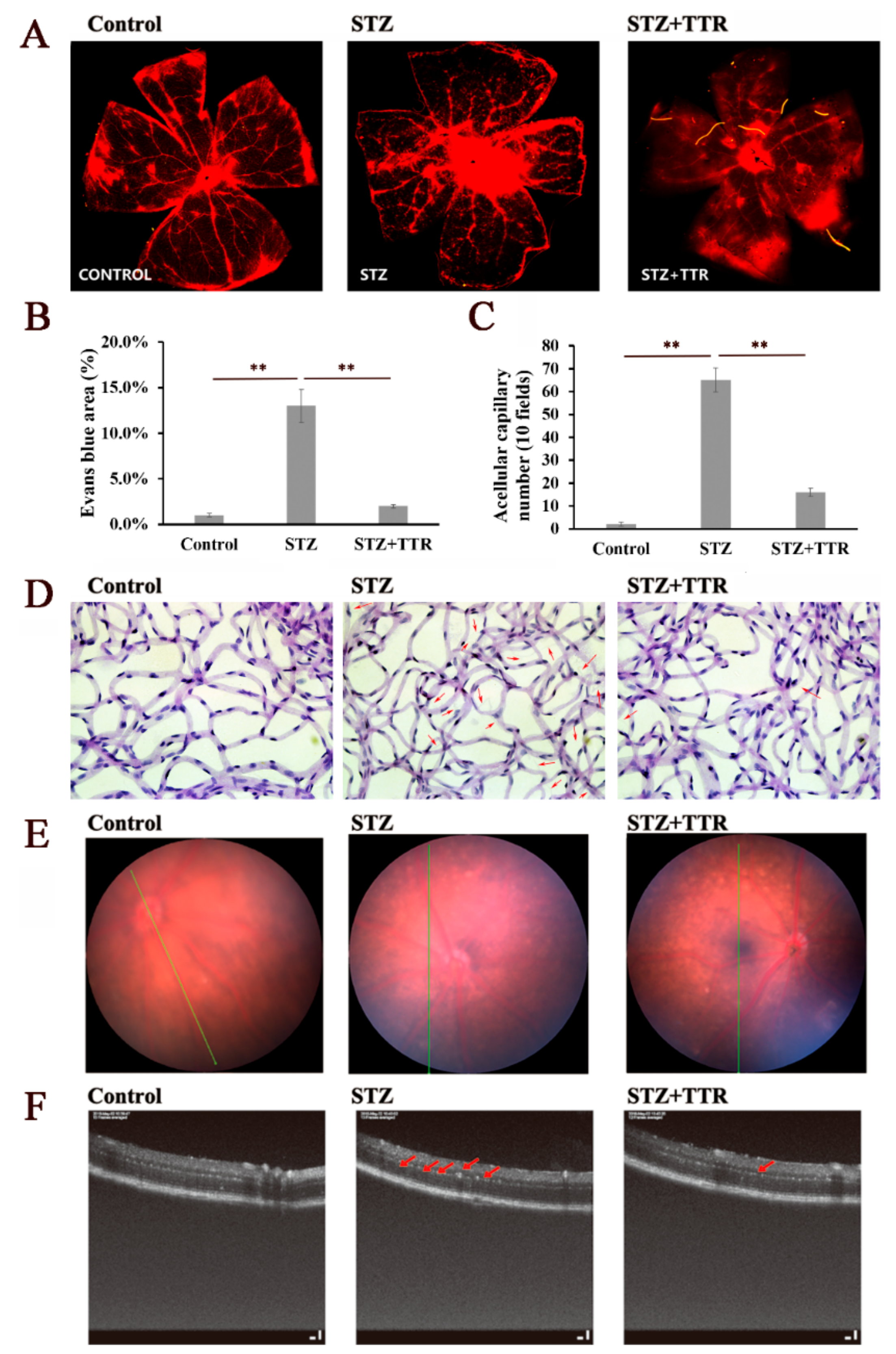
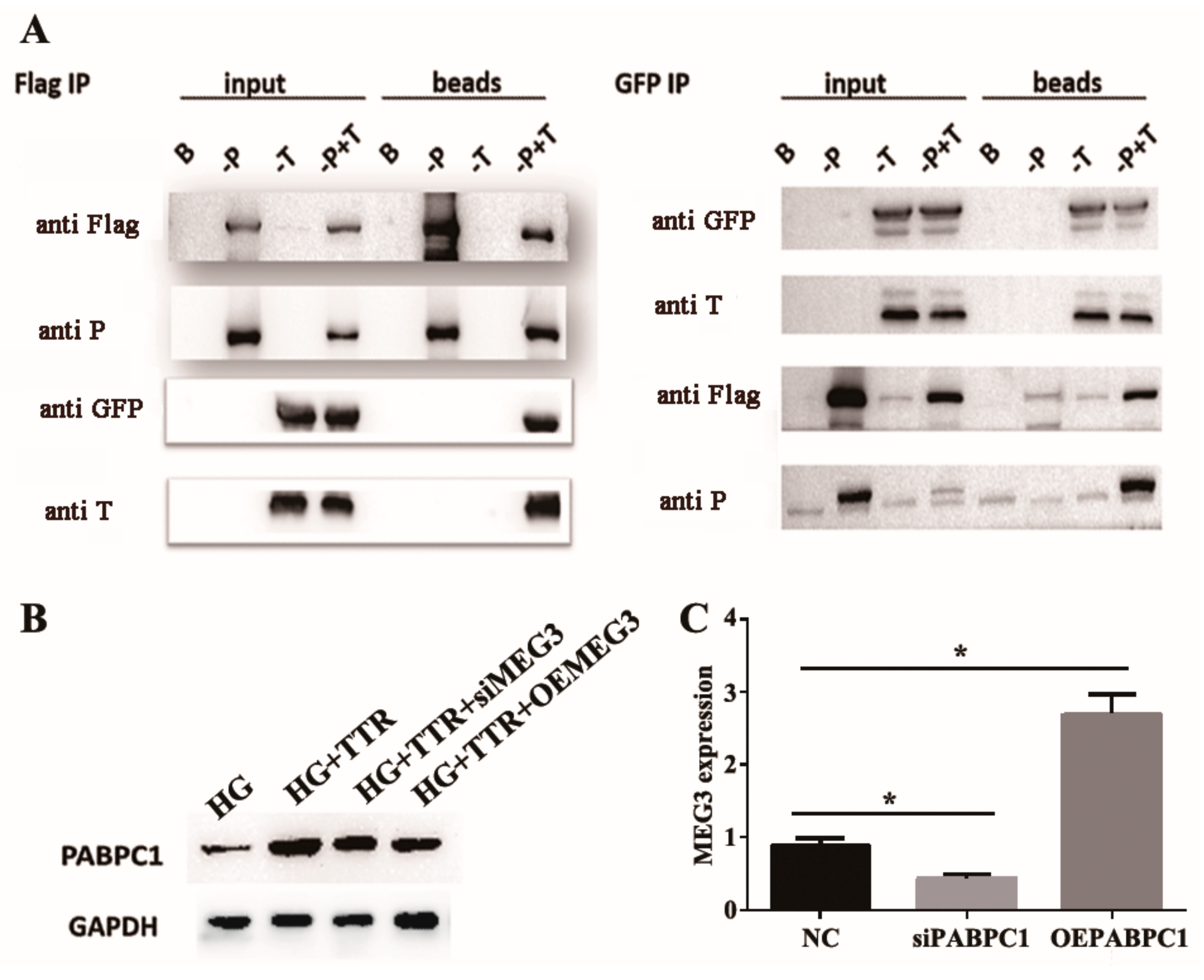
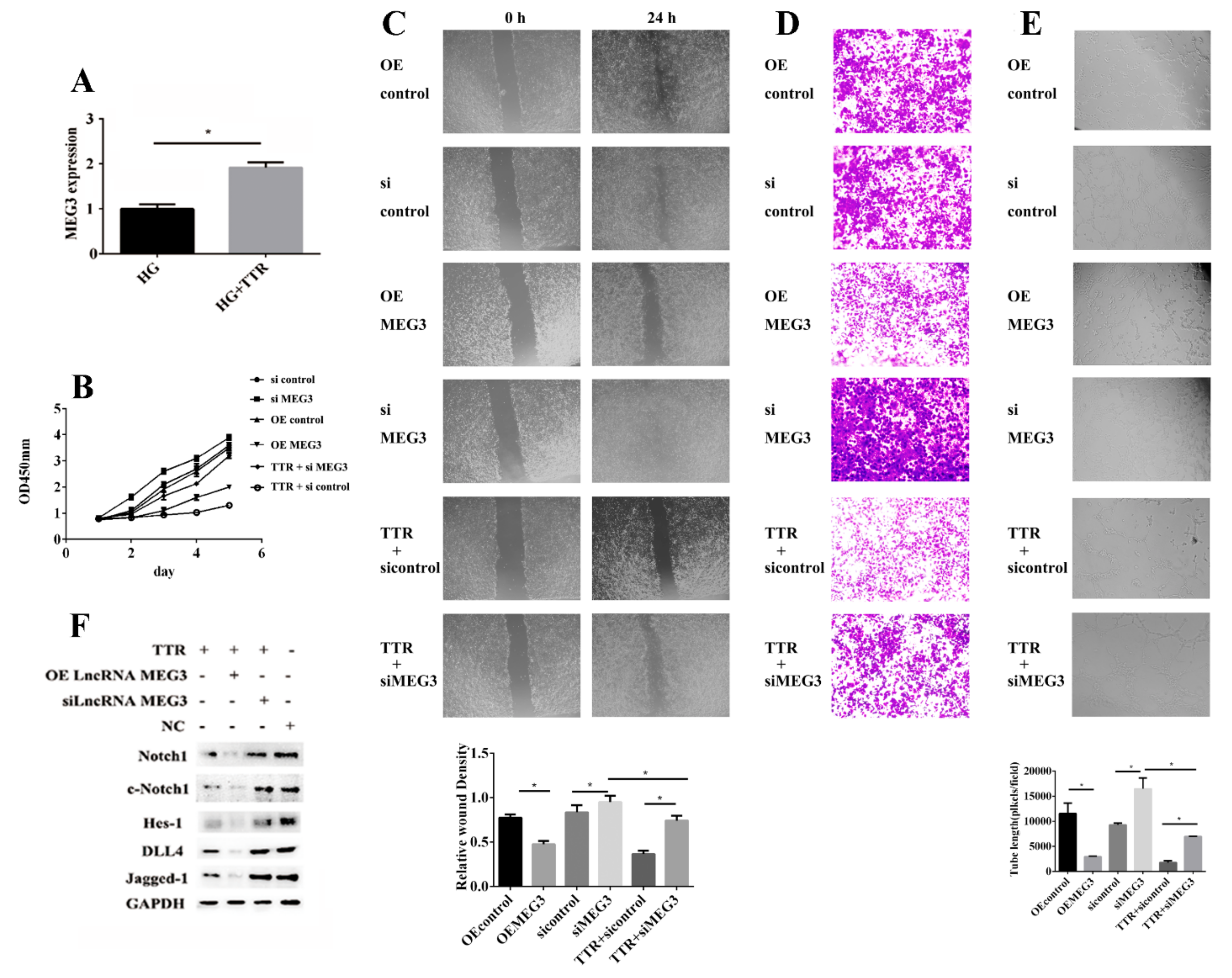

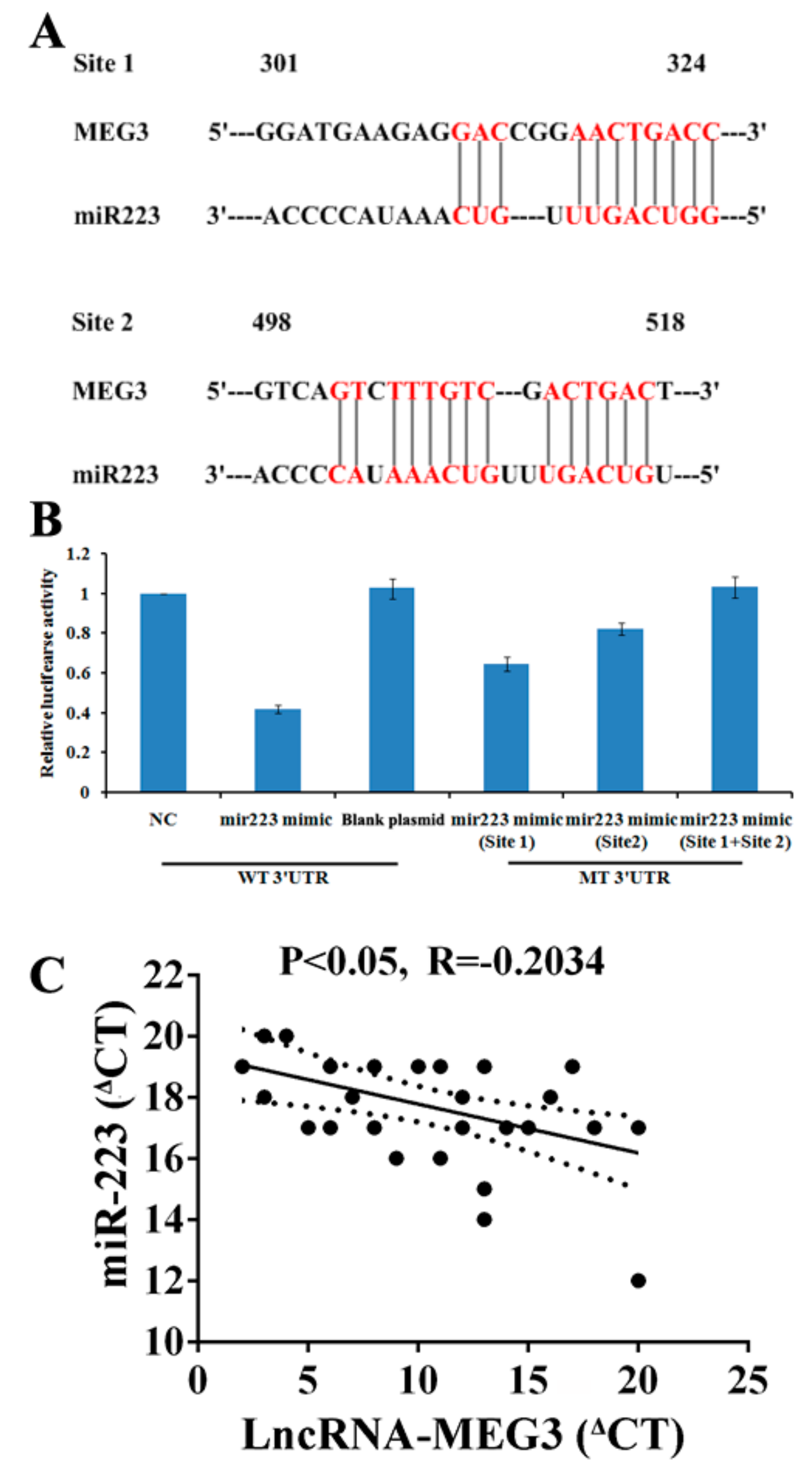
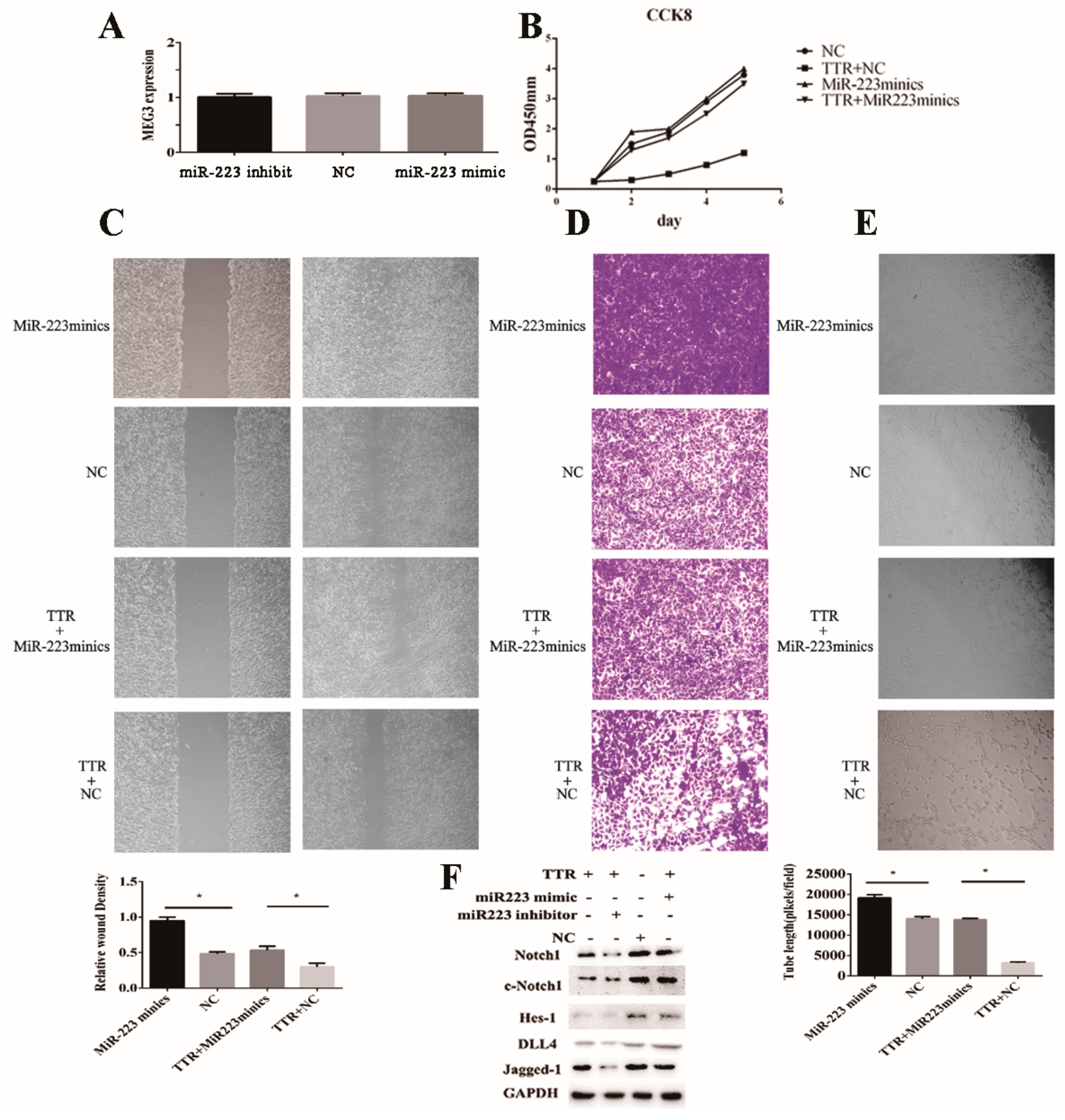
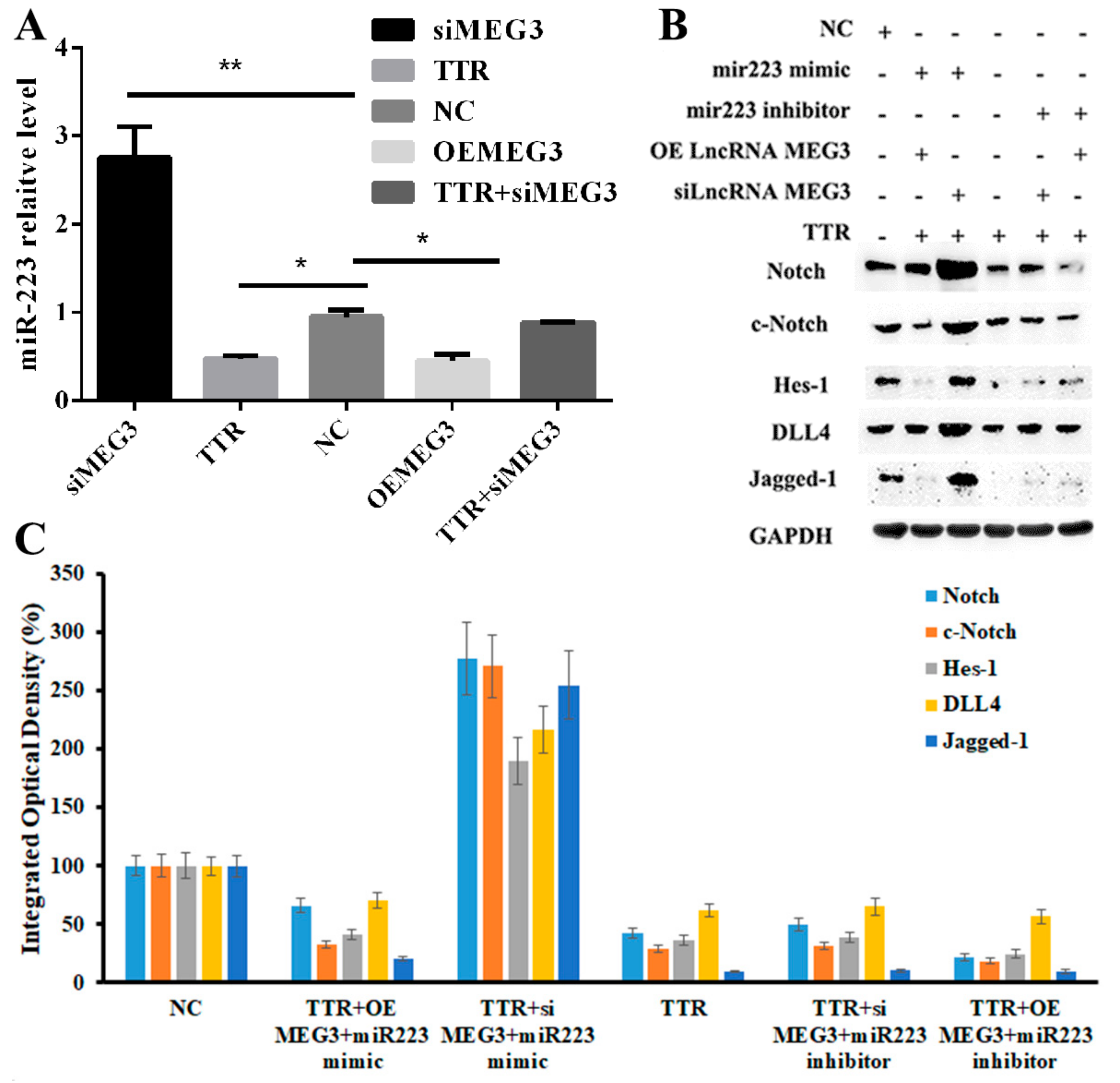
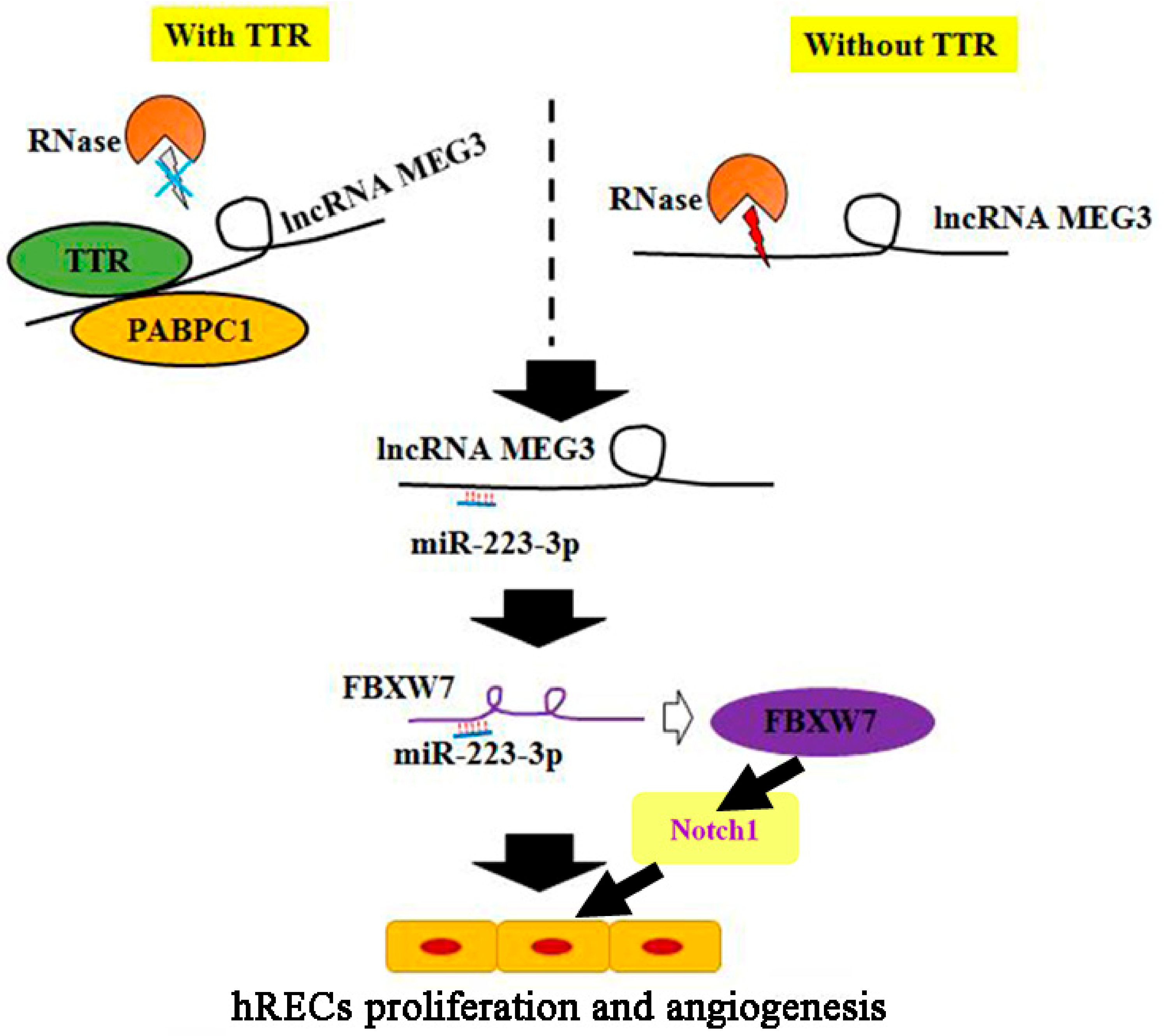
| Initial | 3 Months | 6 Months | Surviving Number | |||||
|---|---|---|---|---|---|---|---|---|
| Body Weight (g) | Glucose (mmol/L) | Body Weight (g) | Glucose (mmol/L) | Body Weight (g) | Glucose (mmol/L) | Start | End | |
| Non-diabetic (Ctrl) | 25.2 ± 2.1 | 6.51 ± 0.52 | 45.5 ± 2.7 | 6.22 ± 0.31 | 65.3 ± 3.7 | 6.88 ± 0.55 | 12 | 12 |
| STZ | 25.1 ± 1.9 | 25.1 ± 1.2 * | 32.1 ± 1.5 * | 25.5 ± 1.5 * | 39.5 ± 2.8 * | 26.5 ± 0.56 * | 12 | 6 |
| STZ + Vector | 27.9 ± 2.2 | 28.8 ± 3.2 * | 35.4 ± 3.8 * | 30.2 ± 2.7 * | 44.6 ± 5.8 * | 32.3 ± 3.5 * | 12 | 7 |
| STZ + scr + TTR | 31.4 ± 4.3 | 27.4 ± 2.6 * | 30.6 ± 1.9 * | 33.4 ± 4.1 * | 37.4 ± 4.4 * | 32.2 ± 3.6 * | 12 | 7 |
| STZ + TTR | 24.9 ± 2.3 | 26.5 ± 2.1 * | 34.1 ± 1.3 * | 26.5 ± 1.3 * | 40.5 ± 3.2 * | 28.3 ± 1.2 * | 12 | 8 |
| STZ + lncRNA-MEG3 | 25.6 ± 1.6 | 26.1 ± 1.4 * | 35.6 ± 1.5 * | 26.7 ± 1.2 * | 41.2 ± 2.9 * | 27.5 ± 1.5 * | 12 | 7 |
| STZ + scr | 25.9 ± 1.3 | 27.1 ± 2.5 * | 34.6 ± 1.2 * | 26.8 ± 1.1 * | 42.3 ± 2.5 * | 29.5 ± 1.9 * | 12 | 6 |
| STZ + lncRNA-MEG3 shRNA | 25.7 ± 2.5 | 26.3 ± 1.9 * | 35.1 ± 2.3 * | 26.5 ± 1.8 * | 41.5 ± 2.4 * | 30.3 ± 2.1 * | 12 | 6 |
| STZ+ lncRNA-MEG3 shRNA + TTR | 29.6 ± 3.8 | 29.1 ± 4.2 * | 33.8 ± 3.0 * | 30.2 ± 4.7 * | 42.4 ± 3.1 * | 34.7 ± 4.5 * | 12 | 8 |
| Primers | ||
|---|---|---|
| miR-223-3p | Sense | 5′-CAGAAAGCCCAATTCCATCT-3′ |
| Antisense | 5′-GGGCAAATGGATACCATACC-3′ | |
| cel-miR-39-3p | Sense | 5′-GTCACCGGGTGTAAATCAG-3′ |
| Antisense | 5′-GGTCCAGTTTTTTTTTTTTTTTCAAG-3′ | |
| Lnc-MEG3 | Sense | 5′-AGCGCTTCTGAAGACCAAAC-3′ |
| Antisense | 5′-GAACACAAAGACACCCAGCA-3′ | |
| GAPDH | Sense | 5′-GCACCGTCAAGGCTGAGAAC-3′ |
| Antisense | 5′-TGGTGAAGACGCCAGTGGA-3′ | |
© 2019 by the authors. Licensee MDPI, Basel, Switzerland. This article is an open access article distributed under the terms and conditions of the Creative Commons Attribution (CC BY) license (http://creativecommons.org/licenses/by/4.0/).
Share and Cite
Fan, G.; Gu, Y.; Zhang, J.; Xin, Y.; Shao, J.; Giampieri, F.; Battino, M. Transthyretin Upregulates Long Non-Coding RNA MEG3 by Affecting PABPC1 in Diabetic Retinopathy. Int. J. Mol. Sci. 2019, 20, 6313. https://doi.org/10.3390/ijms20246313
Fan G, Gu Y, Zhang J, Xin Y, Shao J, Giampieri F, Battino M. Transthyretin Upregulates Long Non-Coding RNA MEG3 by Affecting PABPC1 in Diabetic Retinopathy. International Journal of Molecular Sciences. 2019; 20(24):6313. https://doi.org/10.3390/ijms20246313
Chicago/Turabian StyleFan, Guangming, Yu Gu, Jiaojiao Zhang, Yu Xin, Jun Shao, Francesca Giampieri, and Maurizio Battino. 2019. "Transthyretin Upregulates Long Non-Coding RNA MEG3 by Affecting PABPC1 in Diabetic Retinopathy" International Journal of Molecular Sciences 20, no. 24: 6313. https://doi.org/10.3390/ijms20246313
APA StyleFan, G., Gu, Y., Zhang, J., Xin, Y., Shao, J., Giampieri, F., & Battino, M. (2019). Transthyretin Upregulates Long Non-Coding RNA MEG3 by Affecting PABPC1 in Diabetic Retinopathy. International Journal of Molecular Sciences, 20(24), 6313. https://doi.org/10.3390/ijms20246313







